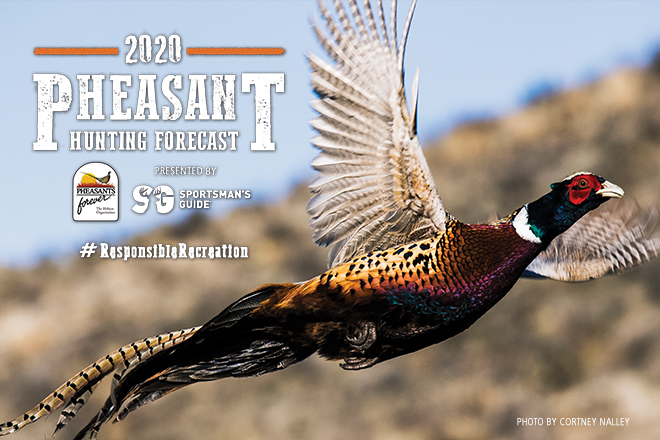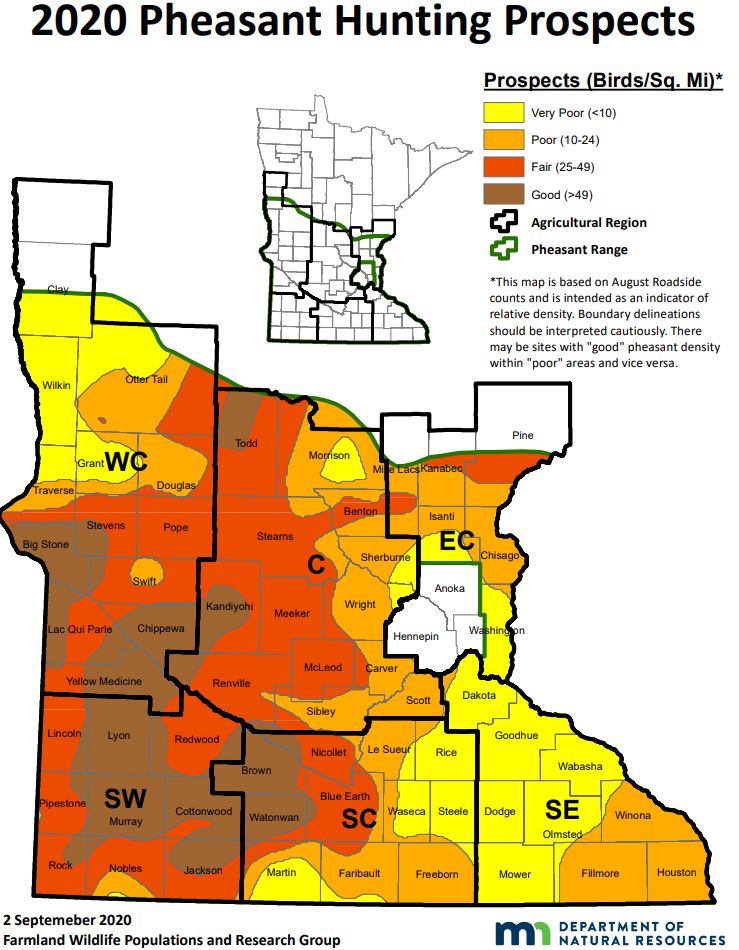
Excellent spring nesting conditions drive Minnesota’s roadside pheasant count up 42 percent. Opportunities for good rooster hunting will abound this year.
Editor’s Note: If you’re reading this forecast, you must hunt pheasants. If you hunt pheasants and don’t belong to Pheasants Forever or you need to renew, it’s time. In Minnesota alone, PF enhances and restores an average of 8,000 acres of existing public lands annually, and since inception has helped make more than 55,000 acres permanently public. Upland habitat, public lands and hunting heritage need you. Join, renew or extend and for a limited time get a sweet PF Hoodie to boot!
By Tom Carpenter
Look at the historical record of Minnesota’s annual roadside pheasant survey, done every year since 1955, and the correlation is clear: More pheasants counted means more pheasants in the bag. With good winter survival from last year (these birds are always tougher than we think) and almost ideal nesting and brood-rearing conditions, thanks to good habitat where we have it, and thanks to good weather, those broods drove the roadside count this year.
There are pheasants waiting to be hunted out there. Here’s the scoop.
LAST YEAR’S HUNT
Let’s start with a look back at 2019’s hunt.
“Our 2019 small game report has yet to be released,” says Tim Lyons, upland game research scientist with the Minnesota Department of Natural Resources (DNR), “so I don’t have the specific number on last year’s pheasant harvest just yet. But based on what I heard from folks out hunting, it was than what they expected based on the 2019 roadside report.”
“I also heard that folks did see a lot of really young birds in the first weeks of the 2019 season,” adds Lyons. “Birds young enough that hunters couldn’t be sure whether they were hens or roosters. This is kind of what we expected given the rain and flooding last year. We likely undercounted hens and missed late-hatched broods because there were still a fair number of active nesting attempts during the time period when the roadside counts occurred in 2019.”
WEATHER AND CONDITIONS
Winter is always a factor in Minnesota.
“It seems like pheasants came through pretty well,” says Lyons. “A lot of folks got worried later in winter given the amount of snow, but it doesn’t seem like it was an issue. And there were no big spring snow storms this year.”
“Counts of roosters and hens were up this year in the survey,” says Lyons, “but it’s hard to herald it as a true population increase especially given we likely undercounted hens last year and it’s just luck-of-the draw as to what day a route is surveyed.”
“I am a lot more confident about our counts of broods and chicks representing a real difference,” he adds.
“Folks who live near the routes they run have reported seeing as many as two to three times the number of pheasants along the same stretch of road compared to last year, depending on the day,” says Lyons. “This includes all birds — hens, chicks, and roosters — and a lot of that variability is due to the presence or absence of broods, not just adults. The upshot is, we really can’t say that just because we counted more hens and roosters this year, that they survived better last winter or if there are really more … just that we counted more.”
As pheasant hunter though, we’ll take it: Higher numbers on a scientific count replicated for decades.
Spring and summer conditions were good for nesting and brood rearing, and that has helped. “Yes, conditions really have been excellent,” says Lyons. “No spring or early summer flooding to speak of. And we actually had drier than normal conditions along the western edge of the state” during peak nesting and brood-rearing times. “That gave hens enough time to successfully nest or re-nest and pull off a successful brood.”
HABITAT, BROODS AND COUNTS
The pheasant habitat we have in Minnesota “is looking really good,” says Lyons. “We and partners such as Pheasants Forever keep acquiring habitat.” It’s notable that the focus there is on properties, or areas of properties, that are unproductive for crops.
“We avoided a severe drought this summer,” adds Lyons, “and that could have adversely affected chick survival, so no worries there. There will be no fall burning this year, but some WMAs may have been opened to emergency haying and grazing. Haying/grazing needed to have been included in the site’s management plan prior to the emergency order that permitted this.”
The good news is clear: “A lot more broods, larger broods, and older broods,” says Lyons. “The estimated peak hatch was slightly earlier than the long-term average and we even had folks age broods such that their estimated hatch was late April and early May.”
June was for the most part dry and warm, which is excellent for raising chicks, given the good habitat from spring rains.
It all shows in Minnesota’s roadside survey results.
This year’s statewide pheasant index was 53.5 birds per 100 miles of roads driven. All regions of the pheasant range reported an increase in pheasant counts, with the southwest reporting the greatest increase—there, observers counted 90.5 birds per 100 miles, a 146 percent increase compared to 2019.
“Numbers on average are up 42 percent statewide and that puts us ahead of the 10-year average,” says Lyons, “although the 10-year period we are now using is 2010-2019 when pheasant numbers have been at historic lows.”
“But we are seeing more broods per 100 hens, even more than our long-term average,” he points out. “This suggests that although we’re seeing fewer hens overall, they are more successful. This is consistent with what we know/ expect about how the amount and quality of habitat out there. We have fewer birds because of less habitat overall (primarily CRP), but we’re more focused on larger blocks of habitat and higher quality vegetation, both of which we know improves nest success and chick survival.”

TOP SPOTS
Where to focus your efforts this fall?
“Southwest is a target, as always,” says Lyons. “They saw an increase of more than 100 percent in the number of birds counted this year. Also, there is lots of public land in addition to private land open through the Walk-in-Access program (requires a $3 validation in addition to the small game license and pheasant stamp).”
“Then I think anywhere west and south of Mankato area, or up along the western edge of the state and even toward just west of the cities, will be good,” says Lyons. “I guess you’d call it the the West Central and Central regions.”
“Our prospect map tends to ‘shrink’ differences between areas with large numbers of birds and those with few,” he explains. “It also ignores that our routes are set up to monitor long term trends, not sample ‘ideal’ habitat. So counties that appear to have low numbers might just have limited habitat/opportunities.”
Translation: Don’t overthink. It has been a good year for raising pheasants. Look for good habitat. Just hunt.
INSIDER TIP
Lyons echoes that last idea.
“The weather was great for breeding this year and I think there will be good opportunities for harvesting birds across the state’s pheasant range,” he says, “and that means even in counties that ‘appear’ to have few birds.”
“If you can, scout ahead or find WMAs or other lands with a good mix of gras and native forbs,” he advises. “You’ll find good numbers of birds. Everyone goes to the Southwest. That’s fine. But those willing to venture elsewhere in the state might find the hunting to be equally good … and certainly less crowded.”
To read even more about Minnesota’s 2020 pheasant hunting prospects, visit
here.
To view the full 2020 Minnesota DNR August Roadside Survey Report, visit
here.
Tom Carpenter is editor at Pheasants Forever.